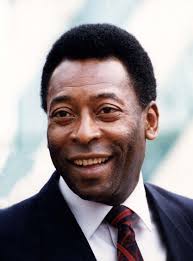PELE
Pelé was born Edson Arantes do Nascimento on October 23, 1940 in Três Corações, Brazil, the first child of João Ramos and Dona Celeste. Named after Thomas Edison and nicknamed “Dico,” Pelé moved with his family to the city of Bauru as a young boy.
João Ramos, better known as “Dondinho,” struggled to earn a living as a soccer player, and Pelé grew up in poverty. Still, he developed a rudimentary talent for soccer by kicking a rolled-up sock stuffed with rags around the streets of Bauru. The origin of the “Pelé” nickname is unclear, though he recalled despising it when his friends first referred to him that way.
As an adolescent, Pelé joined a youth squad coached by Waldemar de Brito, a former member of the Brazilian national soccer team. De Brito eventually convinced Pelé’s family to let the budding phenom leave home and try out for the Santos professional soccer club when he was 15.

Soccer’s National Treasure
Pelé signed with Santos and immediately started practicing with the team’s regulars. He scored the first professional goal of his career before he turned 16, led the league in goals in his first full season and was recruited to play for the Brazilian national team.
The world was officially introduced to Pelé in the 1958 World Cup in Sweden. Displaying remarkable speed, athleticism and field vision, the 17-year-old erupted to score three goals in a 5-2 semifinal win over France, then netted two more in the finals, a 5-2 win over the host country.
The young superstar received hefty offers to play for European clubs, and Brazilian President Jânio Quadros eventually had Pelé declared a national treasure, making it legally difficult for him to play in another country. Regardless, Santos club ownership ensured its star attraction was well paid by scheduling lucrative exhibition matches with teams around the world.
Despite the disappointment on the world stage, the legend of Pelé continued to grow. In the late 1960s, the two factions in the Nigerian Civil War reportedly agreed to a 48-hour ceasefire so they could watch Pelé play in an exhibition game in Lagos.
The 1970 World Cup in Mexico marked a triumphant return to glory for Pelé and Brazil. Headlining a formidable squad, Pelé scored four goals in the tournament, including one in the final to give Brazil a 4-1 victory over Italy.
Pelé announced his retirement from soccer in 1974, but he was lured back to the field the following year to play for the New York Cosmos in the North American Soccer League, and temporarily helped make the NASL a big attraction. He played his final game in an exhibition between New York and Santos in October 1977, competing for both sides, and retired with a total of 1,281 goals in 1,363 games.

The Legend Lives On
Retirement did little to diminish the public profile of Pelé, who remained a popular pitchman and active in many professional arenas.
In 1978, Pelé was awarded the International Peace Award for his work with UNICEF. He has also served as Brazil’s Extraordinary Minister for Sport and a United Nations ambassador for ecology and the environment.
Pelé was named FIFA’s “Co-Player of the Century” in 1999, along with Argentine Diego Maradona. To many, his accomplishments on the soccer field will never be equaled, and virtually all great athletes in the sport are measured against the Brazilian who once made the world stop to watch his transcendent play.




